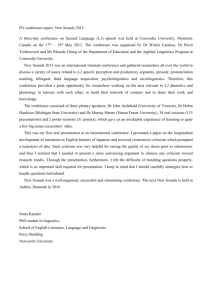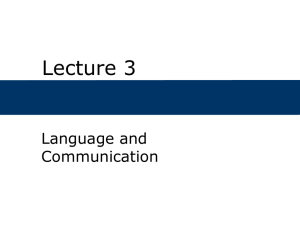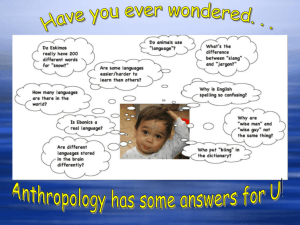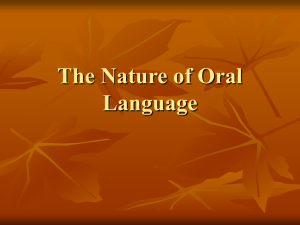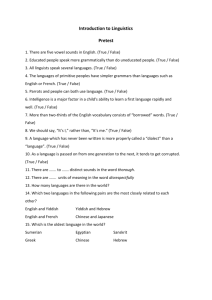Lesson 1 powerpoint
advertisement
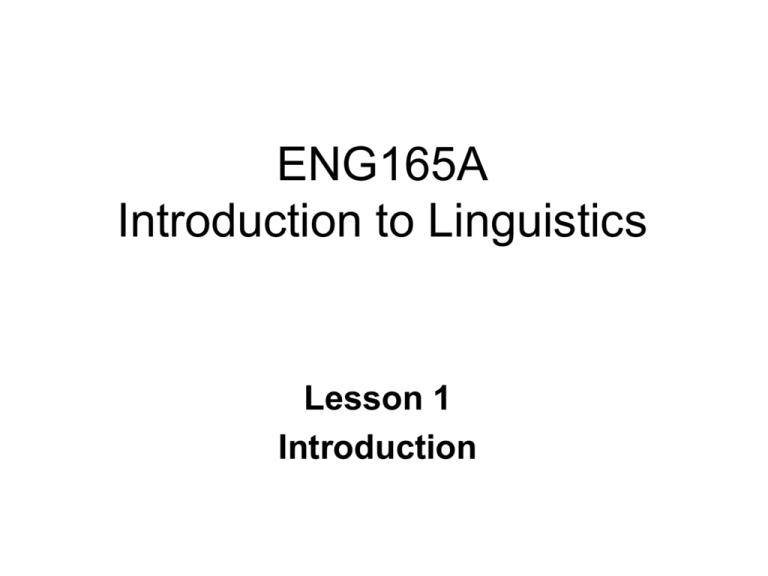
ENG165A
Introduction to Linguistics
Lesson 1
Introduction
Instructor
• Cecilia Li
• ceciliali@chuhai.edu.hk
• Appointment by email
2
Schedule
•
•
•
•
Course introduction
Questionnaire
Quiz
Mini-lecture on linguistics
3
Questionnaire
Complete the questionnaire and let us know
your expectation of the course.
4
Quiz
Do the quiz and see how much you
already know!
Statement 1
There are five vowel sounds in English.
Statement 1
English is written with five vowel
LETTERS. However, those letters serve
to represent as many as 12 to 15
SOUNDS, depending on your variety of
English. For example, the letter "u"
represents 3 different sounds in the
words 'but', 'put', 'butte'.
Useful websites on IPA
http://web.uvic.ca/ling/resources/phonlab/
ipatut/index.html
http://www.oupchina.com.hk/dict/phonetic
/home.html
http://www.eduquery.com/archives/ipa.ht
m
Statement 2
Educated people speak more
grammatically than do uneducated
people.
Statement 2
Educated people tend to conform more
closely to the norms of a "standard"
variety of a language (English in Englishspeaking countries, French in Frenchspeaking countries, etc.) than do people
without formal education.
Statement 3
All linguists speak several languages.
Statement 3
Depending on what you mean by
"linguist". One dictionary definition of
"linguist" is "someone who speaks two or
more languages". By this definition, the
statement is obviously true.
Statement 4
The languages of primitive peoples have
simpler grammars than languages such
as English or French.
Statement 4
All languages are complex. Some of the
languages which have the greatest
complexity in details of how words are put
together, etc. are, in fact, spoken by
people in some of the least
technologically advanced cultures.
Statement 5
Parrots and people can both use language.
Statement 5
Parrots have the ability to mimic sounds
of various types, including words and
phrases of human languages. However, a
parrot could not learn to combine the
word-like sounds that it can mimic into
new combinations to create sentences
which it had not heard before.
Statement 6
Intelligence is a major factor in a child's
ability to learn a first language rapidly and
well.
Statement 6
All children in all cultures acquire the
languages of their cultures at about the
same rate and following similar paths,
starting with one-word utterances, then
combinations of two words, then more
complex utterances with the cute
"mistakes" we recognize as baby talk,
and so on.
Statement 7
More than two-thirds of the English
vocabulary consists of "borrowed" words.
Statement 7
If one goes through an unabridged
dictionary of English, one finds that as
many as 2/3 of the words listed there
have come into English from other
languages. That is, these words were not
part of the vocabulary of English as it was
spoken, say, 1000 years ago.
Statement 8
We should say, "It's I," rather than, "It's me."
Statement 8
The answer here is similar to that for
Statement 2 above. If "should say" means
that this is what we were taught in school
and it is therefore the norm which we
should follow, then this statement is true.
If "should say" means that we are not
speaking "real English" if we do
otherwise, then it is false.
Statement 9
A language which has never been written
is more properly called a "dialect" than a
"language".
Statement 9
If by "dialect" you mean "a non-written
variety of speech", this statement is, by
definition, true, but this is an incoherent
and unacceptable use of the word
"dialect". Properly used, the word
"dialect" refers to "a variety of language
showing systematic differences from
other varieties of THE SAME
LANGUAGE".
Statement 10
As a language is passed on from one
generation to the next, it tends to get
corrupted.
Statement 10
If "corrupted" means "changed", then this
would be true, but normally persons who
make such statements as this mean
"degenerated".
Statement 11
Hawaiian Pidgin should not be taught in
schools because it prevents children from
learning proper English.
Statement 11
Hawaii Pidgin English, Hawaii Creole
English, HCE, or simply Pidgin, is a
creole language based in part on English
used by most “local” residents of Hawaii.
Pidgin is used by many Hawaii residents
in everyday conversation and is often
used in advertising toward Hawaii
residents.
Statement 12
There are 3 to 5 distinct sounds in the
word thorough.
Statement 12
The sounds are:
th = a single "fricative" sound made by
passing air between tongue and teeth
or = for some speakers, a single sound like
the "rr" sound in 'bird'; for other speakers,
two sounds, i.e. a vowel like the vowel in 'but'
and an 'r'
ough = for some speakers a single sound,
'o'; for other speakers, two sounds, 'o'
followed by 'w'
Statement 13
There are 4 units of meaning in the word
disrespectfully.
Statement 13
The 4 units of meaning are:
dis- means "not, negative“
-respect- means "deference“
-ful- added to the noun respect to
make an adjective ("full of respect")
-ly added to an adjective to make an
adverb ("in a manner of respecting")
Statement 14
How many languages are there in the
world?
Statement 14
Several thousand.
Statement 15
Which two languages in the following
pairs are the most closely related to each
other?
– English and Yiddish
– Yiddish and Hebrew
– English and French
– Chinese and Japanese
– Hawaiian and Tagalog
Statement 15
English and Yiddish
These are both "Germanic" languages.
Statement 16
Which is the oldest language in the
world?
– Sumerian
– Egyptian
– Sanskrit
– Greek
– Chinese
– Hebrew
Statement 16
• Sumerian: records dating from about 3100
BC (5100 years)
• Egyptian: 3000 BC
• Sanskrit: 1500 BC
• Greek: 1400 BC (oldest records in the
Greek alphabet, ca. 1000 BC)
• Chinese: 1300 BC
• Hebrew: 1100 BC
Can You Recognize These Logos?
39
Top 10 Advertising Slogans?
No
1.
Slogan
Impossible is nothing.
2.
Agree
I do!
Company
Adidas
Nike
3.
Think small.
4.
5.
Diamonds are forever.
6.
The ultimate driving machine.
BMW
7.
Does she ... or doesn't she?
Clairo
8.
Because I'm worth it.
L'Oréal
9.
10.
Volkswagen
DeBeers
KFC
McDonalds
40
M&M candies
Top 10 Advertising Slogans?
No
Slogan
Agree
I do!
Company
1.
Impossible is nothing.
2.
Just do it.
3.
Think small.
4.
5.
Diamonds are forever.
Finger lickin' good.
6.
The ultimate driving machine.
BMW
7.
Does she ... or doesn't she?
Clairo
8.
Because I'm worth it.
L'Oréal
9.
I’m lovin’ it.
10. M&Ms melt in your mouth, not in your
Adidas
Nike
Volkswagen
DeBeers
KFC
McDonalds
41
M&M candies
What is Linguistics?
– Etymology: Latin lingua language, tongue
• Linguistics is NOT:
speaking many languages
translating / interpreting
working on one’s language skills
42
What is Linguistics?
LINGUISTICS =
SCIENTIFIC STUDY OF LANGUAGE
• Scientific methodology: observations form
hypotheses hypothesis testing theory
43
What is Language?
Language is a system of symbols
for thinking and communicating.
• Language is a tool we have been using to understand
and develop our thinking. We have been:
– Learning about the thinking of others by reading
– Expressing our own thinking through writing
– Exchanging ideas with others by speaking and
listening
• Thought and language can contribute to clear, effective
thinking and communication.
44
Clarify Thinking
• The relationship between thinking and
language is interactive; both processes are
continuously influencing each other in many
ways.
Clear Language
Specific
Distinct
Precise
Accurate
Clear Thinking
Specific
Distinct
Precise
Accurate
Clear and precise language leads to clear and precise thinking.
45
Clarify Thinking
• Vague language - using words that are very imprecise and general.
Vague words are words that lack a clear and distinct meaning.
Examples:
–
–
–
–
I had a nice time yesterday
That is an interesting book
She is an old person
She is a beautiful girl
• Ambiguous language - also interfere with the clear expression of
thoughts. An ambiguous word is a word with more than one (1) meaning
that is open to different interpretations.
Examples:
–
–
–
–
He fed her dog biscuits
The duck is ready to eat
Flying planes can be dangerous
The shooting of the hunter disturbed him
The Rock says
you should
avoid vague
and ambiguous
language.
46
What is Language?
• Language: A symbolic means of
communication that is shared by several
individuals
– Symbolic: words symbolize or represent ideas
and concepts
– Communication: thoughts → public message
– Shared: known to more than one user
47
Characteristics of Language
Semanticity
• speech sounds = meaning (unlike clearing your throat,
coughing)
Arbitrariness
• Symbols of language (letters & sounds -> words) have
no direct relationship with the meaning they convey
– Exception: onomatopoeia
48
Characteristics of Language
Productivity (Infinity)
• Language is generative
• With a small number of words and grammatical rules,
one can generate an infinite number of utterances
Flexibility
• Connection between a word and its meaning is not
fixed
• Novel words (neologisms)
• Other word for the same concept
49
Natural Language
Language that develops automatically in
humans
Modes of natural language
ORAL = SPOKEN LANGUAGE
MANUAL = SIGN LANGUAGE
e.g. ASL = American Sign Language
NOTE: this is NOT the same as body language /
gestures
(We will NOT be concerned with body language
and gestures.)
50
Spoken vs. Written Language
Spoken Language
natural system
biologically determined
develops automatically
“acquired” – not “learned”
Written Language
extra, superimposed system
culturally determined
optional
“learned” intentionally
51
What does it mean to know a language?
Knowledge of the Sound System
(Phonetics and Phonology)
Knowledge of words (Morphology and
Lexicon)
Knowledge of structure: how to form
correct sentences (Syntax)
Knowledge of meaning (Semantics)
52
Pronunciation:
Level of Phonetics/Phonology
WHITE DOVE /
/
baak6 gaap2
53
Word Form/ Structure:
Level of Morphology
• Two morphemes: {white} and {dove}
• Cantonese (Hong Kong Chinese):
– hoeng1 gong2 dak6 bit6 hang4 zing3 keoi1
'The Hong Kong Special Administrative Region
(HKSAR)’
– hoeng1 gong2 wui6 ji5 zin2 laam5 zung1 sam1
‘The Hong Kong Convention and Exhibition
Centre’
54
Phrase/ Sentence Structure:
Level of Syntax
WHITE DOVE
• PS rule:
NP A + N
• Tree diagram:
NP
A
|
white
N
|
(1) Who did you see Chan with?
(2)*Who did you see Chan and?
(3) ngo5 heoi3 zung1 waan4
(4) heoi3 zung1 waan4
(5)*zung1 waan4 heoi3 ngo5
dove
55
Meaning:
Level of Semantics
What does the sign, white dove, mean?
• English:
a. Chan loves you more than
Yan.
could mean:
b. Chan loves you more than
Yan loves you.
c. Chan loves you more than
Chan loves Yan.
• Cantonese:
a. me1 waa2 ?
could mean:
b. What did you say?
c. What language?
56
Meaning:
Level of Pragmatics
• What would white dove mean in some
specialized contexts, cultures, etc.?
• Pragmatics: meaning in context
– It’s hot!!
hou2 jit6 aa3
‘Hot’=
1._________
2._________
57
Topics in linguistics
•
•
•
•
•
PHONETICS AND PHONOLOGY
MORPHOLOGY
SYNTAX
GRAMMAR
SEMANTICS
58

